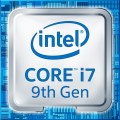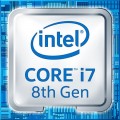Code name
This parameter characterizes, firstly, the technical process (see above), and secondly, some features of the internal structure of processors. A new (or at least updated) codename is introduced to the market with each new CPU generation; chips of the same architecture are "coevals", but may belong to different series (see above). At the same time, one generation can include both one and several code names.
Here are the most common Intel codenames today:
Cascade Lake-X (10th gen),
Comet Lake (10th gen),
Comet Lake Refresh (10th generation),
Rocket Lake (11th generation),
Alder Lake (12th generation),
Raptor Lake (13th generation),
Raptor Lake Refresh (14th generation).
For AMD, this list includes
Zen+ Picasso,
Zen2 Matisse,
Zen2 Renoir,
Zen3 Vermeer,
Zen3 Cezanne,
Zen4 Raphael,
Zen4 Phoenix and
Zen5 Granite Ridge.
Cores
The number of physical cores provided in the processor design. The core is the part of the processor that is responsible for executing the instruction stream. The presence of multiple cores allows the CPU to work simultaneously with several tasks, which has a positive effect on performance. Initially, each physical core was intended to operate with one thread of commands, and the number of threads corresponded to the number of cores. However, today there are many processors that support multi-threading technologies and are capable of executing two streams of commands on each core at once. For more information about this, see “Amount of threads”.
Desktop processors
have 2 cores (2 threads), as a rule, typical for budget models.
2 cores (4 threads) and
4 cores are typical for inexpensive mid-class solutions.
4 cores (8 threads),
6 cores,
6 cores (12 threads),
8 cores - a strong mid-range.
8 cores (16 threads),
10 cores,
12 cores,
16 cores and
more are characteristic features of advanced models, including processors for servers and workstations.
At the same ti
...me, it is worth considering that the actual capabilities of the CPU are determined not only by this parameter, but also by other characteristics - primarily by series and generation / architecture (see the corresponding paragraphs). It is not uncommon for situations where a more advanced and/or new dual-core processor turns out to be more powerful than a quad-core chip from a more modest series or an earlier architecture. So it makes sense to compare CPUs by the number of cores within the same series and generation.Threads
The number of instruction streams that the processor can execute at the same time.
Initially, each physical core (see "Number of cores") was intended to execute one thread of instructions, and the number of threads corresponded to the number of cores. However, there are many processors today that support Hyper-threading or SMT (see below) and can run two threads on each core at once. In such models, the number of threads is twice the number of cores — for example, 8 threads will be indicated in a quad-core chip.
In general, a higher number of threads, other things being equal, has a positive effect on speed and efficiency, but increases the cost of the processor.
Multithreading
Processor support for Hyper-threading.
Hyper-threading is actually a variant of simultaneous multithreading (SMT) developed by Intel and used in its chips since 2002. This technology is used to optimize the load on each physical processor core. Its key principle (simplified) is that each such core is defined by the system as 2 logical cores — for example, the system “sees” a dual-core processor as a quad-core one. At the same time, each physical core constantly switches between two logical cores, in fact, between two threads of commands: when a delay occurs in one thread (for example, in case of an error or while waiting for the result of the previous instruction), the core does not idle, but starts executing the second thread commands. Thanks to this technology, the response time of the processor is reduced, and in server systems, stability is increased with numerous connected users.
In AMD processors, a similar function is used under the original name SMT (see below).
Clock speed
The number of cycles per second that the processor produces in its normal operating mode. A clock is a single electrical impulse used to process data and synchronize the processor with the rest of the computer system. Different operations may require fractions of a clock or several clocks, but anyway, the clock frequency is one of the main parameters characterizing the performance and speed of the processor — all other things being equal, a processor with a higher clock frequency will work faster and better cope with significant loads. At the same time, it should be taken into account that the actual performance of the chip is determined not only by the clock frequency, but also by a number of other characteristics — from the series and architecture (see the relevant paragraphs) to the number of cores and support for special instructions. So it makes sense to compare by clock frequency only chips with similar characteristics belonging to the same series and generation.
TurboBoost / TurboCore
The maximum processor clock speed that can be reached when running in Turbo Boost or Turbo Core overclocking mode.
The name "Turbo Boost" is used for the overclocking technology used by Intel, "Turbo Core" for the solution from AMD. The principle of operation in both cases is the same: if some cores are not used or work under a load below the maximum, the processor can transfer part of the load from the loaded cores to them, thus increasing computing power and performance. Operation in this mode is characterized by an increase in the clock frequency, and it is indicated in this case.
Note that we are talking about the maximum possible clock frequency — modern CPUs are able to regulate the operating mode depending on the situation, and with a relatively low load, the actual frequency may be lower than the maximum possible. See "Clock frequency" for the general meaning of this parameter.
L1 cache
The amount of Level 1 (L1) cache provided by the processor.
Cache is an intermediate memory buffer into which the most frequently used data from RAM is written when the processor is running. This speeds up access to them and has a positive effect on system performance. The larger the cache, the more data can be stored in it for quick access and the higher the performance. Level 1 cache has the highest performance and the smallest volume — up to 128 KB. It is an integral part of any processor.
L2 cache
The amount of Level 2 (L2) cache provided by the processor.
Cache is an intermediate memory buffer into which the most frequently used data from RAM is written during processor operation. This speeds up access to them and has a positive effect on system performance. The larger the cache, the more data can be stored in it for quick access and the higher the performance. Level 2 cache volume can reach 12 MB, the vast majority of modern processors have such a cache.
Instruction
Support by the processor of various sets of additional commands. These can be instructions that optimize the operation of the processor as a whole or with applications of a certain type (for example, multimedia, or 64-bit), prevent certain types of viruses from running on the computer, etc. Each manufacturer has its own assortment of instructions for CPUs.

